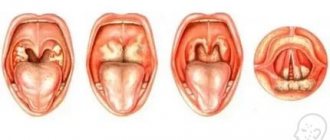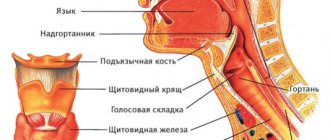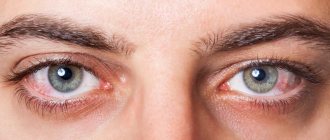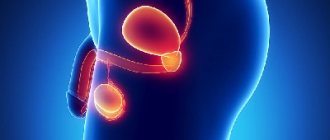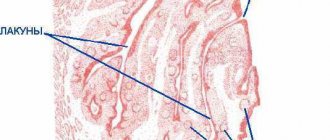What is angioedema of the larynx? Most likely, most respondents not related to medicine will not be able to answer this question. But if you voice another name for this condition - Quincke's edema - everything will fall into place.
Angioedema of the larynx is an acute, rapidly developing edema of the deep layers of the skin, subcutaneous tissue and mucous membrane. Angioedema of the larynx is very dangerous, because in the absence of emergency help, the airways can completely block, leading to asphyxia and death.
Angioedema of the larynx is an aggressive reaction of the body to external stimuli. When interacting with an external factor, the body releases biologically active substances into the blood as protective measures - histamine, bradykinin, etc. This whole process occurs with the expansion of blood vessels and an increase in their permeability. Ultimately, the lymph from the capillaries leaks into nearby tissues, causing severe swelling. The mechanism of angioedema formation is similar to the appearance of allergic urticaria. Only in the latter case, the vessels dilate in the upper layers of the skin, so urticaria is not dangerous, but in case of angioedema of the larynx - in the deep layers of the skin.
This is a relatively new medical condition. It was first described in his works at the end of the 19th century by the German physician Heinrich Quincke. Swelling of the throat develops very quickly - several hours or even minutes can pass from the moment of interaction with the irritant. Therefore, treatment and assistance for swelling of the throat should be urgent.
Symptoms of Quincke's edema.
The first sensations that a person experiences are a burning sensation and a slight tingling sensation at the site of future swelling. Then swelling occurs. Dangerous swelling appears on the face (lips, eyelids, cheeks) and neck. The tongue is very swollen. It gets to the point where a person’s face becomes like a ball, and the patient is not even able to fully open his eyes.
In the first minutes after interaction with the irritant, symptoms may appear in adults and children, such as lacrimation, problems breathing through the nose, the appearance of a dry cough and hoarseness in the voice. Another important symptom of angioedema of the throat is “wheezing”, heavy breathing. All these symptoms very quickly gain momentum and become intense. It’s as if a person was bitten by a swarm of bees - this is what angioedema looks like externally.
In addition to external changes, this dangerous condition has other symptoms: decreased blood pressure, excessive sweating, and rapid heartbeat.
Angioedema of the larynx is the most dangerous manifestation of angioedema, when swelling affects the throat and airways. An emerging cough, sore throat, difficulty swallowing, a feeling of a lump in the throat, problems with speech - all these symptoms indicate incipient asphyxia (suffocation).
When the first symptoms of Quincke's edema appear, you need to call an ambulance so as not to waste precious time. If the swelling of the larynx is not relieved soon, the person may die. Even if death was avoided and treatment of angioedema was not delayed, prolonged absence of normal breathing can lead to damage to brain activity.
Prevention
It is impossible to ensure that your throat never hurts, especially in the autumn-winter period. But prevention can be carried out regularly to reduce the risk of illness and strengthen the immune system. For this:
- stop smoking if you smoke - nicotine irritates and dries out the mucous membrane of the nose and throat, making them vulnerable to pathogens;
- eat a varied and nutritious diet so that the body receives vitamins and minerals in full;
- humidify the indoor air - artificial indoor fountains, aquariums, diffusers, and water containers are suitable for this. Too dry air is a strong irritant to the throat and contributes to the appearance of microtraumas on the mucous membrane;
- wash your hands more often - pathogenic bacteria, as a rule, enter our body from dirty hands;
- take vitamins - they support the immune system;
- dress according to the weather - during hypothermia, blood vessels narrow, which destroys the protective mechanism of the mucous membrane and the person catches a cold. The cold itself does not contribute to this;
- do not self-medicate - there is a high risk of complications, for example, in the form of hearing loss or disease of the ears, lungs, eyes or brain.
If you feel unwell, consult a doctor. You can make an appointment with a multidisciplinary medical otolaryngologist using the feedback form or by calling.
Causes of laryngeal edema.
In addition to knowing about the first signs of angioedema, you need to understand why, in principle, this dangerous condition can arise.
Typically, angioedema is of an allergic nature, but there are cases when the human body is affected not by allergens, but by other external factors.
The most common causes of angioedema of the larynx are:
- certain foods (for example, eggs, chocolate, etc.);
- plant pollen during the flowering period;
- fungi;
- household chemicals;
- taking medications;
- insect bites;
- dust;
- pet hair or excretions;
- exposure to open sun;
- hypothermia;
- stressful situations;
- digestive problems;
- heredity.
Swelling of the throat - what is it?
People of all ages can experience an extremely dangerous condition, symptomatically described as swelling of the throat. This secondary pathology (not an independent disease) is expressed in a narrowing of the lumen of the larynx and indicates the development of diseases of various origins or injury to the organ. Swelling of the throat, the causes of which are inflammatory or non-inflammatory in nature, according to the nature of the course can be:
- lightning - manifests itself in cases of injury to nearby tissues or allergies; the clinical picture is formed within a few minutes;
- acute - accompanies inflammatory processes and infectious diseases; temporary establishment of a full-scale clinic takes up to several hours;
- chronic - detected in the event of neoplasms (benign or malignant); Full development of clinical manifestations requires from several days to several weeks.
Types of edema.
There are several types of Quincke's edema.
Angioedema can be hereditary or acquired. Hereditary angioedema is a rare genetic disease that was first described at the end of the 19th century and is characterized by recurrent edema. If a mother or father has this diagnosis, the probability that their child will be born with the same diagnosis is 50%. With timely prevention and proper treatment, the patient’s attacks rarely occur, and the patient lives quite well with this diagnosis. Cases of acquired disease are quite small, and are most often observed in elderly patients.
Depending on the cause that caused Quincke's edema, allergic, non-allergic and idiopathic edema are distinguished when the cause of the condition could not be determined.
General information
Laryngeal edema develops if fluid quickly accumulates in the area of the epiglottis, vocal cords and supraglottic folds - in the submucosal layer - and tissues swell. As a result, the glottis is significantly reduced, the function of the larynx is impaired, and oxygen starvation may develop. A particularly severe condition is laryngeal stenosis , in which the lumen is significantly narrowed or completely closed.
This condition is dangerous for human life. Laryngeal edema can develop as a result of inflammation of the larynx or pharynx itself. Also, such a symptom is sometimes a consequence of a number of other diseases or pathological processes. The condition may be limited or diffuse. With this pathology, a person experiences a change in voice, sore throat, and a feeling of a foreign body.
What causes can provoke laryngeal edema and how to carry out first aid and treatment for this condition will be discussed in this article.
First aid for Quincke's edema.
How to relieve Quincke's edema? The first thing you should do when you find yourself next to a person with signs of angioedema is to call an ambulance.
What to do in case of Quincke's edema before the doctors arrive?
- First, unbutton the patient's clothes, loosen the tie, remove chains, beads, etc., thereby ensuring air flow. If you are indoors, open a window to let fresh air in.
- Make the patient more comfortable and try to calm him down by saying that doctors will arrive soon and begin treatment. This condition puts the patient into shock, which only worsens respiratory failure.
- If the problem began due to contact with an allergen, eliminate it if possible.
- Give the patient a tablet of any antihistamine that is in your home medicine cabinet. If the person cannot swallow, crush the tablet and place it under the person's tongue.
- Give the patient food more often if he can swallow, preferably with mineral water.
- If swelling is caused by contact with an allergen, give the patient activated carbon, Enterosgel or Polysorb to reduce the concentration of the allergic substance in the body.
- The patient's feet should be kept warm. You can place them in a bath of warm water or wrap them well.
- Place any vasoconstrictor drops into the patient's nose.
- It is necessary to measure the patient's blood pressure, and if it falls below 90, it is necessary to administer adrenaline to the patient.
Even if the patient feels better as a result of the measures provided, under no circumstances should one refuse medical care.
Allergic swelling of the throat
Severe development is characterized by swelling of the throat due to allergies. Many substances and agents can act as allergens - dust, insect bites, animal hair, some medications, foods, etc. Allergic swelling of the throat is expressed by specific signs in addition to the main symptoms:
- nasal congestion and discharge (rhinitis);
- bronchospasm;
- diarrhea and skin rashes;
- lacrimation.
A particularly dangerous form of allergic swelling of the throat is Quincke's edema.
Treatment of angioedema of the larynx.
Treatment of angioedema consists of two stages. The first is emergency care, the second is hospital treatment. Before starting treatment, the cause of angioedema is determined, and then a treatment regimen is prescribed. This may include:
- taking antihistamines (“Suprastin”, “Loratadine”, “Tavegil”);
- corticosteroid drugs (for example, Prednisolone, Dexamethasone, Nasonex, Celeston);
- diuretics (for example, Furosemide);
- enterosorbents for removing allergens and toxins (for example, Multisorb);
- enzyme preparations (“Pancreatin”, “Festal”);
- administration of a C1 inhibitor, a blood protein whose deficiency leads to non-allergic angioedema;
- administration of fresh frozen plasma (for non-allergic edema);
- administration of androgens - sex hormone preparations (for non-allergic edema).
Pathogenesis
Edema develops as a consequence of swelling of the laryngeal tissue due to an inflammatory process or other factors. As a result, neuro-reflex mechanisms are disrupted, and increased sensitivity of the immune system is noted. As a result, edema leads to a narrowing of the lumen of organs.
Allergic swelling of the larynx develops as a reaction of the body to a specific allergen. In allergies, the main role in the pathogenesis of edema is played by mediators that are produced during the degranulation of tissue basophils and blood basophils. Under the influence of these mediators, vasodilation occurs, vascular permeability increases, itching , hyperemia swelling develops .
Treatment with folk remedies
Treatment with folk remedies can be practiced only if the condition does not cause significant discomfort and does not threaten human life. In such a situation, the use of traditional methods makes it possible to reduce the severity of swelling and the discomfort associated with it. The following traditional methods can be practiced:
- Gargling . For rinsing, use a soda solution (1 teaspoon of soda should be diluted with a glass of water), as well as herbal decoctions. For this purpose, you can prepare decoctions of chamomile, calendula, and mint. If the condition is not associated with allergies, you can add 1-2 drops of eucalyptus essential oil to the solution or decoction. Also, for gargling, herbal mixtures are used, which must be mixed in equal proportions. The following collections are used: sage and oak bark; chamomile and calamus root; calendula and nettle. To prepare the decoction, you need to take 2 tsp. collection or herbs, add 200 ml of water and boil for several minutes. You should gargle several times a day, carrying out the procedure for 7-10 minutes.
- Carrot juice with honey . It is recommended to drink this remedy three times a day, freshly prepared. Prepare it by mixing 100 ml of juice and 1 tsp. honey
- Rose hip decoction . It is recommended to drink it to remove excess fluid from the body. To prepare the decoction, you need to brew 1 tbsp. l. rose hips in 1 liter of water. The product should be left for several hours and drunk 100 ml three times a day.
Forecast
Depends on the cause of the development of swelling, the rate of progression of the pathological process and the timeliness of medical care.
- If fulminant edema , there is a risk of asphyxia and death.
- With acute edema, the risk of death is lower. With the correct approach to treating the underlying disease, the prognosis is favorable.
- In a chronic process, an unfavorable prognosis can only be associated with the severity of the underlying disease.
Allergic pharyngitis. Diagnostics
An otolaryngologist can diagnose pharyngitis through a visual examination, but the type and nature of the allergen is determined by an allergist. Therefore, you need advice from two specialists at once.
Diagnosis of this disease includes the following studies:
- collection of anamnesis of the disease;
- pharyngoscopy, which allows you to examine the back of the throat for swelling and mucus formation;
- skin tests (detect the presence of patient hypersensitivity to the agent);
- laboratory tests for various allergens.
1 Pharyngoscopy - examination of the pharynx by an otolaryngologist at MedicCity
2 Pharyngoscopy - examination of the pharynx by an otolaryngologist at MedicCity
3 Laboratory diagnosis of allergic pharyngitis
Diet
Hypoallergenic diet
- Efficacy: therapeutic effect after 21-40 days
- Timing: constantly
- Cost of products: 1300-1400 rubles. in Week
Diet for edema
- Efficacy: healing effect
- Dates: as prescribed by a doctor
- Cost of products: 1400-1500 rubles per week
If you are prone to swelling of the larynx, it is necessary, first of all, to exclude all those foods that can provoke an allergic reaction. Since it is not always known which food can cause an allergy, all potentially dangerous foods should be removed from their diet.
During illness, you should also exclude the following foods:
- Spicy and smoked dishes.
- Sweets.
- Pickles - the amount of salt should be kept to a minimum.
- Canned food.
- Alcohol.
The following products are allowed:
- Fresh green vegetables, herbs.
- Potatoes, legumes.
- Lean meat - beef, chicken.
- Dairy products.
- Apples, pears.
- Cereals.
- Vegetable oils.
- Bread.
If a person has a tendency to allergies, then he must follow a hypoallergenic diet for life.
How to recognize swelling of the throat
It can be difficult to understand that the throat is swollen, since the process begins inside and it is difficult to see it on your own. Symptoms of pathology:
- pain and discomfort when swallowing;
- labored breathing;
- stiffness of neck movements;
- irradiation of pain to the ear area;
- dry hacking cough;
- sensation of a foreign body in the larynx;
- change in voice timbre;
- visual increase in neck thickness.
Sometimes swelling of the throat is accompanied by an increase in body temperature. This is typical for an infectious process.


